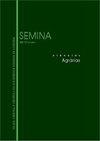圣卡塔琳娜高原土壤中普通豆根瘤菌的结瘤和生物固氮作用
IF 0.5
4区 农林科学
Q4 AGRICULTURE, MULTIDISCIPLINARY
引用次数: 0
摘要
库里提巴诺斯镇是圣卡塔琳娜州第三大常规豆类产地(Phaseolus vulgaris L.)。然而,由于氮肥成本等问题,区域产量下降。农民不使用种子接种,因为接种剂的根瘤菌性能低,适应土壤气候条件。通过体外吲哚乙酸(IAA)生产和磷酸盐增溶,对36株根瘤菌进行了分离、鉴定和评价,作为根瘤菌选择的辅助工具。92%的菌株产生IAA, 64%的菌株可溶解磷酸钙。连续两年进行田间试验的分离株为RBZ14和RBZ15。RBZ14产生的IAA量高于CIAT899(推荐接种剂),RBZ15产生的IAA量较低。对于磷酸盐的增溶,所有的都表现出相似的性能。在第一年,分离株提高了TAA大马品种叶片氮含量。RBZ15提高了生产率。第二年,在IPR Tuiuiú品种中,分离株也提高了叶片氮含量,在产量上没有差异,但增加了120和205 kg。ha-1分别与RBZ14和RBZ15接种。因此,这表明它们在不同基因型中具有BNF的潜力,并且对其机制的评估可能有助于选择更有效的根瘤菌。本文章由计算机程序翻译,如有差异,请以英文原文为准。
Nodulation and biological nitrogen fixation of common bean rhizobia from Santa Catarina Plateau soils
Curitibanos town is the third regular bean producer (Phaseolus vulgaris L.) in Santa Catarina. However, the regional production decreased due to problems such as the nitrogen fertilizers cost. Farmers do not use seed inoculation because of inoculant’s rhizobia low performance and adaptation to edaphoclimatic conditions. Thus, 36 rhizobia were isolated, characterized, and evaluated by in vitro indole acetic acid (IAA) production and phosphate solubilization, as auxiliary tools to the rhizobia selection. Ninety-two percent of the isolates produced IAA and 64% solubilized calcium phosphate. The isolates selected for field trials during two consecutive years were RBZ14 and RBZ15. RBZ14 produced an IAA higher amount than strain CIAT899 (recommended for inoculants) and RBZ15 formed a lower amount. For phosphate solubilization, all showed similar performance. In the first year, the isolates increased leaf N contents in the TAA Dama cultivar. RBZ15 increased the productivity. In the second year, in the IPR Tuiuiú cultivar, the isolates also increased leaf N contents, and there was no difference at productivity but increments of 120 and 205 kg.ha-1 with RBZ14 and RBZ15 inoculations, respectively. Therefore, it suggested their potential for BNF in different genotypes and that evaluated mechanisms may help to the selection of a more efficient rhizobia.
求助全文
通过发布文献求助,成功后即可免费获取论文全文。
去求助
来源期刊

Semina-ciencias Agrarias
农林科学-农业综合
CiteScore
1.10
自引率
0.00%
发文量
148
审稿时长
3-6 weeks
期刊介绍:
The Journal Semina Ciencias Agrarias (Semina: Cien. Agrar.) is a quarterly publication promoting Science and Technology and is associated with the State University of Londrina. It publishes original and review articles, as well as case reports and communications in the field of Agricultural Sciences, Animal Sciences, Food Sciences and Veterinary Medicine.
 求助内容:
求助内容: 应助结果提醒方式:
应助结果提醒方式:


